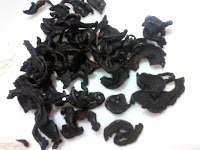There are three different types of Thekera(থেকেৰা) found in Assam that belongs to the same genus 'garcinia'. Bor thekera (Garcinia pedunculata), Rupohi thekera (Garcinia lanceifolia Roxb) and Kuji thekera (Garcinia
 |
| Sun dried thekera pieces |
Food drying is a method of food preservation which can be done by sun, oven or microwave drying. Solar drying is the ancient method of preserving food.
 |
| Bor thekera |
Thekera can be preserved by sun drying method. The sun drying method has been used for the purpose of preserving thekera by Assamese people since time immemorial. The sun dried thekera slices are used for various purposes. You can make a very tasty fish curry with thekera.
 |
| Kuji thekera |
Dried slices of thekera are used as a medicine to aid digestion. Dried slices of thekera are soaked in water for few minutes to prepare a sour liquid and then consumed as a drink to cure stomach related problems.
Process of sun drying is very easy and safe.
Following are the steps you should follow to make sun-dried thekera :
STEP 1
Select a fresh and clean fruit. Wash the fruit under running water.
STEP 2
Cut the fruit in half and remove it's middle seed portion.
STEP 3
Cut lengthwise into thin slices.
STEP 4
Put the thekera fruit slices under direct sunlight for some days.
STEP 5
Turn thrkera slices once per day and don't forget to bring the drying tray inside at night.
STEP 6
Once thekera fruits become dry preserve it in a airtight container.

Comments
Post a Comment